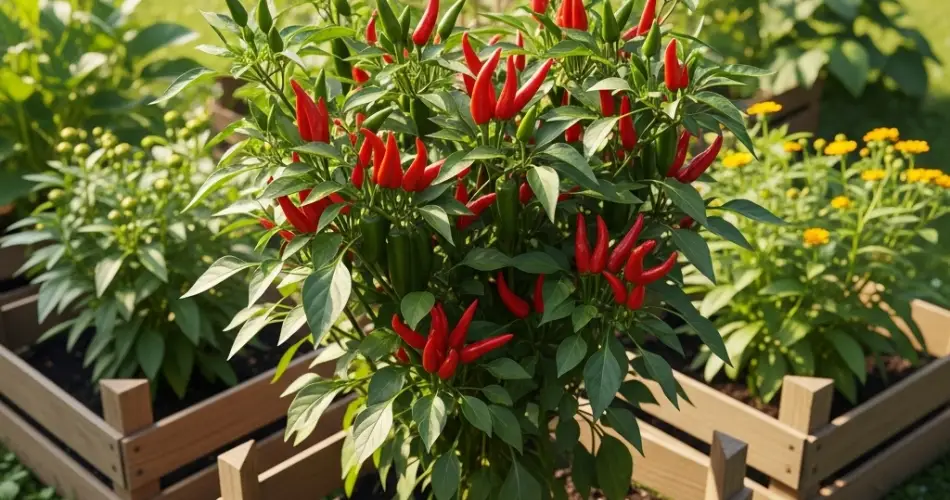For gardeners with limited outdoor space, growing hot chili peppers in crate planters offers a rewarding and practical solution. Whether you live in an apartment, have a small balcony, or a compact patio, using wooden crates as planters allows you to cultivate a spicy crop right at home. This method combines space efficiency with easy maintenance, making it accessible even for beginner gardeners.
Hot chili peppers not only add heat and flavor to meals but also bring vibrant color and life to any small garden. With proper care, your crate-grown chilies can produce abundant harvests throughout the growing season.
Why Choose Crates for Growing Hot Chilies?
Wooden crates provide several advantages for small-space chili gardening:
-
Adequate Root Space: Crates with at least 12 inches of depth give chili plants room for healthy root growth.
-
Excellent Drainage: The natural gaps in wooden crates allow excess water to drain easily, preventing root rot.
-
Portability: Crates are lightweight and can be moved to catch optimal sunlight or shelter from bad weather.
-
Cost-Effective and Eco-Friendly: Using recycled or repurposed crates reduces waste and is budget-friendly.
-
Space Maximization: Crates fit well on balconies, windowsills, or narrow patios, making urban gardening possible.
What You’ll Need to Start
Gather these materials to set up your crate chili garden:
-
Wooden crate(s), ideally at least 12 inches deep and 16–18 inches wide
-
Landscaping fabric or burlap for lining
-
Quality potting soil mixed with compost or aged manure
-
Hot chili pepper seeds or seedlings (varieties like cayenne, jalapeño, or Thai chilies work well)
-
Mulch (optional)
-
Twine or small stakes for support
-
Watering can or hose with gentle spray nozzle
Ensure your crates are untreated and sturdy. Line them with fabric to retain soil but allow water to escape.
Preparing Your Crate Planters
-
Line the Crate
Attach landscape fabric or burlap inside the crate to keep soil from falling out. This also helps with moisture retention while ensuring proper drainage. -
Fill with Soil
Mix potting soil with compost or organic matter at a 3:1 ratio. Fill the crate almost to the top, leaving 1–2 inches for watering space. -
Positioning
Place your crate in a sunny location that receives at least 6 hours of direct sunlight daily. Chilies thrive in warmth and full sun.
Planting Your Chili Peppers
-
Select the Right Varieties
For small-space gardening, choose compact chili varieties that do well in containers. Popular options include:-
Cayenne
-
Jalapeño
-
Thai chili
-
Serrano
-
-
Transplant Seedlings
When seedlings have at least two sets of true leaves, transplant them into the crate. Space plants about 8–12 inches apart to allow airflow and growth. -
Planting Depth
Dig holes deep enough to cover the root ball completely. Firm the soil around each plant and water immediately.
Caring for Your Chili Plants
-
Watering
Chilies prefer consistently moist soil but dislike soggy conditions. Water when the top inch of soil feels dry, avoiding overwatering. -
Feeding
Use an organic fertilizer high in potassium and phosphorus every two to three weeks after flowers appear to support fruiting. -
Support
Some chili plants may benefit from small stakes or twine to keep branches upright as fruit develops. -
Mulching
Applying mulch helps retain moisture and suppress weeds. -
Pest Control
Keep an eye out for aphids, spider mites, and whiteflies. Organic treatments like neem oil or insecticidal soap can help manage infestations.
Harvesting Your Hot Chilies
Depending on the variety, chilies mature between 60 to 90 days after transplanting. Harvest peppers when they reach full size and color—red, orange, green, or yellow depending on the type.
Use scissors or garden shears to cut peppers from the plant to avoid damaging stems. Frequent harvesting encourages more fruit production.
Troubleshooting Common Issues
-
Blossom Drop: Caused by stress or inconsistent watering. Maintain steady moisture and protect plants from extreme heat.
-
Yellowing Leaves: Often a sign of overwatering or nutrient deficiency. Check soil moisture and consider feeding with balanced fertilizer.
-
Pests and Diseases: Early detection and treatment with organic sprays are essential for healthy plants.
Benefits of Crate Chili Gardening
-
Enables urban and small-space gardeners to grow fresh, spicy produce.
-
Reduces grocery trips and adds freshness to home-cooked meals.
-
Promotes sustainable gardening by reusing materials and reducing food miles.
-
Adds greenery and color to balconies, patios, and small yards.
-
Provides a satisfying gardening experience that fits any lifestyle.
Final Thoughts
Crate planters make hot chili gardening accessible for anyone, regardless of space limitations. With minimal investment and some basic gardening knowledge, you can enjoy an abundant harvest of fresh, flavorful chilies all season long.
Start small with one crate, experiment with different chili varieties, and watch as your balcony transforms into a productive and vibrant garden space. Growing your own hot chilies is a fulfilling way to spice up your meals and your life.



